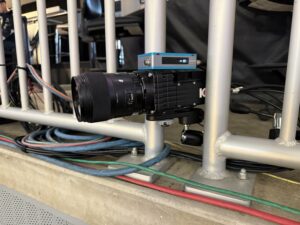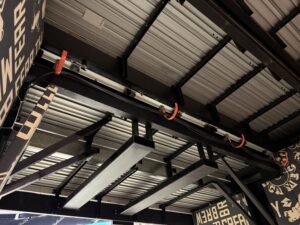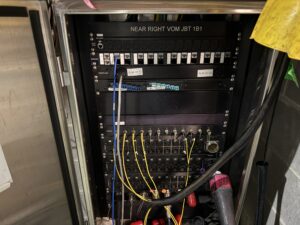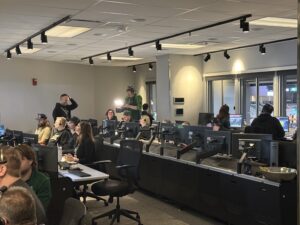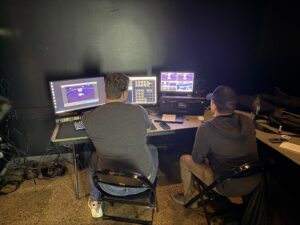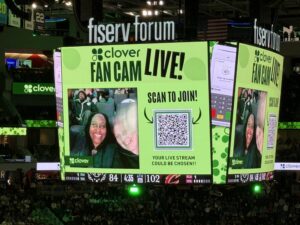From Fiserv Forum to the Forest, Part 2: The Famous Group’s Virtual Camera System, Refined Graphics-Rendering Introduce New Chapter in Mixed Reality
The production leaned heavily on four cameras from IO Industries, Fiserv Forum’s IP connectivity
Story Highlights
Sunday night in Milwaukee was a significant step in the history of mixed-reality (MR) activations at sporting events. To make this robust in-venue open possible, a large amount of technological expertise and workflows were put on display at Fiserv Forum, including The Famous Group’s upgraded virtual camera system, the reliance on the building’s top-tier broadcast infrastructure, the use of pre-rendered graphics for higher fidelity, and more.
“It’s been an incredible collaboration where we’re always willing to try something new,” says Andrew Isaacson, EVP and partner, The Famous Group. “It takes a little bit of trust, but after a decade-long relationship, we’re both in a really good spot.”
To learn about the creative side of this project, click HERE for Part 1 of our two-part report from Milwaukee.
A Strong Tech Infrastructure: Detailed LIDR Scanning, 8K Cameras Impact the Show
The crucial aspect of this activation, the essential LIDAR scan of Fiserv Forum, was done about six weeks ago with the assistance of Laser Scanning Solutions Owner Andy Foshee. During this visit, The Famous Group’s Engineering Producer Justin Molter also surveyed the space to get a better lay of the land. He also received the help of Director, Video Operations, Jeff Bins; Director, Broadcast Technology, Stevan Sokolovic; and numerous engineers including Digital Display Engineer II Joe Frost to acclimate himself with the building’s capabilities.
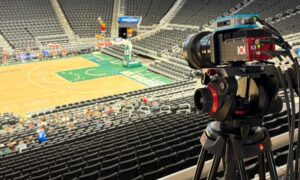
Enhancements in TFG’s virtual-camera technology allows for the cameras to be left alone during the activation.
“We essentially picked out a bunch of locations around the building for our cameras,” says Molter. “We also needed that three-dimensional scan of the entire building to understand how we can converge the augmented-reality graphics with the physical world.”
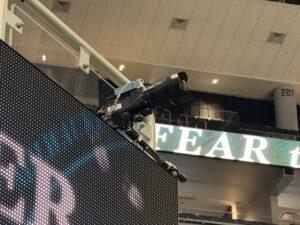
Certain camera positions, including this one focused on the videoboard, provided different angles of the open video.
In addition, the team got a deeper feel of the technological infrastructure that they’d rely on for Sunday’s game. Luckily, this lofty production would be done in one of the newer venues in the National Basketball Association. Opened in August 2018, Fiserv Forum is still a gold standard of the league and is running with a SMPTE 2110-based, IP-flavored control room. With connectivity and efficiency not being an issue, Molter felt a bit more comfortable.
“This state-of-the-art facility allows us to not have to run miles of fiber,” he says. “It’s been awesome having the ability to patch right into the building without a ton of challenges.”
With many resources dedicated to the overall in-venue run of show, The Famous Group’s virtual-camera technology allowed the team to bake in pan, tilt, and zoom features into the MR sequence and sidestep the need for human camera operators. When you match that wrinkle of the production with the pre-production rendering, the material was displayed at a higher quality in a shortened turnaround time.
“This system allows us to set up our camera angles before getting on site,” says Isaacson. “Not only is that important for what we’re trying to do with virtual graphics, but it also helps us explain [to the Bucks] what the narrative’s going to be well ahead of time. The pre-produced aspect gives us a lot more flexibility and time to dial into the details instead of always worrying about the big picture.”
Near the court, the hardware in The Famous Group’s 8K camera system that broadcasted the content were four cameras from IO Industries with Cyanview’s C10 camera interface to synchronize with the Bucks’ IP-based workflows. The video feeds from these cameras were tied back to the in-venue production team via connectivity boxes that are routed back to the control room. The camera positions, including the main concourse level to shoot the court and above the player tunnels to shoot the videoboard, were optimal to showcase the full breadth of the lower bowl and the packed crowd in attendance.
“We want our content to look really amazing, and this 8K technology is going to really help us with that,” says Hemu Karadkar, creative director, The Famous Group. “With our footprint being small, our cameras aren’t bound to the typical broadcast camera positions that are in every stadium, which enhances how the story can be told within the physical environment.”
On gameday, The Famous Group’s Senior Producer Luke Hinojosa and Technical Director Ben Ryle were onsite to insure the activation was produced as smooth as possible.
Staying Ahead of the Pack: Bucks Find Competitive Edge With Upgraded Tech
Around the National Basketball League, the Milwaukee Bucks are perpetually near the top of the most engaging and entertaining in-venue shows. Creativity is a huge reason, but a major factor to their consistency is embracing current technology trends and not being afraid to experiment with new workflows.
“Our leadership team wants us to raise our standards, so we’re constantly talking about what we can do that will separate us from the rest,” says Johnny Watson, executive producer, broadcast and live events, Milwaukee Bucks. “There’s been a ton of evolution with our technology and the way we use our videoboard.”
At The Famous Group, the technological possibilities are wide open with these cameras’ free-range ability and developing graphics with a higher resolution.
“We have always been at the forefront of how to use technology to tell stories,” says Karadkar. “We have amazing people on the tech side that allow our creatives to get excited about what’s next.”
